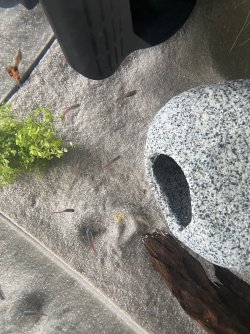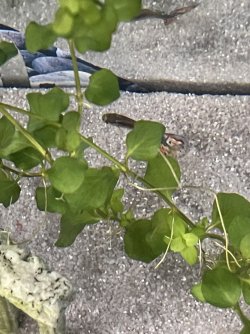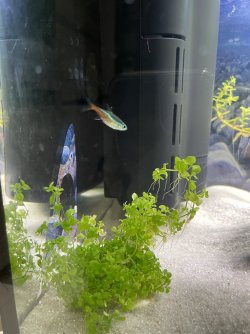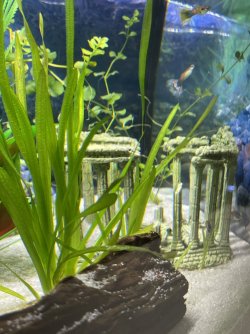guppiesandtetras
New Member
Hi,
First of all, congratulations on such a helpful forum! There have been a few times I’ve looked at various threads over the past couple of weeks and was struck by what a supportive community this is
So - I am a complete newbie, both to the forum and to fish keeping - and am already feeling as though I’ve had dogs and horses needing less attention!

Our tank, which is a new set up for my youngest son (so I’ll be the primary carer!), is 54 litres and over the past month we’ve introduced 6 neon tetras, 3 cherry shrimp and the latest addition 4 days ago were 6 male guppies. We also have live plants, some wood and a cave rock thing to give them plenty of hiding places.
I’ve been religiously checking the water parameters and the last water change was about 25%. I’ve scheduled another water change today but have some questions that I hope you can help me with please. Apologies if they’re daft, I just want to make sure I’m getting things right. The welfare of any loving creature in my care is really important to me.
1. I’ve been spending time watching the fish and their behaviour to get to know their usual patterns of activity etc. As I say, I’m totally new to this so understanding them better seems a good place to start. Today I have noticed that one of our guppies is keeping out of the way in the back corner of the tank near the bottom - in a similar way to when they rest at night. They were only introduced on Saturday (so this is his 4th day here) but up til now, all 6 have been swimming peacefully around the tank during the day. Worried there’s something wrong.
Water:
nitrates: 0
Nitrites: 0/0.5? I find the colour strips so hard to read!
pH: 6.5
KH: 40/80
GH: 30/60
2. Are these yellow things in the 1st photo cherry shrimp eggs? The neon tetras have been dragging them around and trying to eat them. What’s the best thing to do? Try and tuck them into a plant to give some of them a chance to hatch? Or not worry about it…?
3. I’m not convinced that the heater is warming the tank consistently. I’ll try and find a thermometer in the house to double check but the water didn’t feel as warm as it has done. Might this be affecting the guppy that’s put of sorts?
4. I’m finding the API 5 in 1 water test strips really tricky to read accurately. Any recommendations?
5. Feeding..I’m conscious not to overfeed so we give a pinch of flakes once a day - does that sound about right? The guppies poop for England though!! They’re often very long (but NOT white which I think would be a parasite indicator?)
They’re often very long (but NOT white which I think would be a parasite indicator?)
6. How thourough do I need to be when cleaning the sand substrate to get rid of all the guppy waste? As much as possible I guess…
Any advice gratefully received!
Thanks for reading. I’m sure there’ll be plenty more beginner questions from me over the coming weeks and months…you have been warned
First of all, congratulations on such a helpful forum! There have been a few times I’ve looked at various threads over the past couple of weeks and was struck by what a supportive community this is
So - I am a complete newbie, both to the forum and to fish keeping - and am already feeling as though I’ve had dogs and horses needing less attention!
Our tank, which is a new set up for my youngest son (so I’ll be the primary carer!), is 54 litres and over the past month we’ve introduced 6 neon tetras, 3 cherry shrimp and the latest addition 4 days ago were 6 male guppies. We also have live plants, some wood and a cave rock thing to give them plenty of hiding places.
I’ve been religiously checking the water parameters and the last water change was about 25%. I’ve scheduled another water change today but have some questions that I hope you can help me with please. Apologies if they’re daft, I just want to make sure I’m getting things right. The welfare of any loving creature in my care is really important to me.
1. I’ve been spending time watching the fish and their behaviour to get to know their usual patterns of activity etc. As I say, I’m totally new to this so understanding them better seems a good place to start. Today I have noticed that one of our guppies is keeping out of the way in the back corner of the tank near the bottom - in a similar way to when they rest at night. They were only introduced on Saturday (so this is his 4th day here) but up til now, all 6 have been swimming peacefully around the tank during the day. Worried there’s something wrong.
Water:
nitrates: 0
Nitrites: 0/0.5? I find the colour strips so hard to read!
pH: 6.5
KH: 40/80
GH: 30/60
2. Are these yellow things in the 1st photo cherry shrimp eggs? The neon tetras have been dragging them around and trying to eat them. What’s the best thing to do? Try and tuck them into a plant to give some of them a chance to hatch? Or not worry about it…?
3. I’m not convinced that the heater is warming the tank consistently. I’ll try and find a thermometer in the house to double check but the water didn’t feel as warm as it has done. Might this be affecting the guppy that’s put of sorts?
4. I’m finding the API 5 in 1 water test strips really tricky to read accurately. Any recommendations?
5. Feeding..I’m conscious not to overfeed so we give a pinch of flakes once a day - does that sound about right? The guppies poop for England though!!
6. How thourough do I need to be when cleaning the sand substrate to get rid of all the guppy waste? As much as possible I guess…
Any advice gratefully received!
Thanks for reading. I’m sure there’ll be plenty more beginner questions from me over the coming weeks and months…you have been warned








